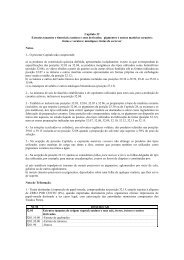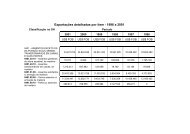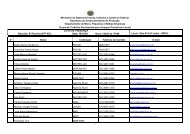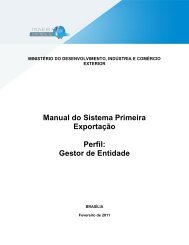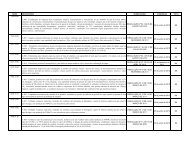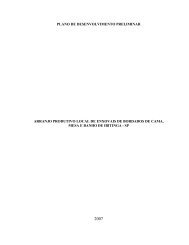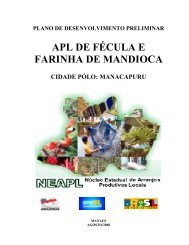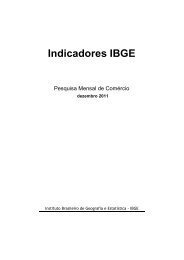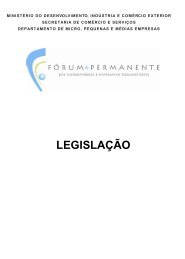Provas 1 e 3 - Ministério do Desenvolvimento, Indústria e Comércio ...
Provas 1 e 3 - Ministério do Desenvolvimento, Indústria e Comércio ...
Provas 1 e 3 - Ministério do Desenvolvimento, Indústria e Comércio ...
You also want an ePaper? Increase the reach of your titles
YUMPU automatically turns print PDFs into web optimized ePapers that Google loves.
LÍNGUA INGLESA<br />
Read the text below in order to answer questions<br />
16 to 18.<br />
Global Trends 2015 – Latin America<br />
By 2015, many Latin American countries will<br />
enjoy greater prosperity as a result of expanding<br />
hemispheric and global economic links, the<br />
information revolution, and lowered birthrates.<br />
Progress in building democratic institutions will<br />
reinforce reform and promote prosperity by<br />
enhancing investor confidence. Brazil and Mexico<br />
will be increasingly confident and capable actors<br />
that will seek a greater voice in hemispheric<br />
affairs. But the region will remain vulnerable to<br />
financial crises because of its dependence on<br />
external finance and the continuing role of single<br />
commodities in most economies. The weakest<br />
countries in the region, especially in the Andean<br />
region, will fall further behind. Reversals of<br />
democracy in some countries will be spurred by a<br />
failure to deal effectively with popular demands,<br />
crime, corruption, drug trafficking, and<br />
insurgencies.<br />
16- According to the text,<br />
a) hardly any of the Latin American countries<br />
count on external financial help.<br />
b) global economic links have been promoting<br />
corruption and insurgencies.<br />
c) Brazil and Mexico have the weakest<br />
economies within the region.<br />
d) few Latin American countries will be<br />
participating in the information revolution.<br />
e) relative affluence may well be achieved by<br />
many Latin American countries.<br />
17- The author refers to the building of democratic<br />
institutions as<br />
a) an unattainable goal in Latin American<br />
countries.<br />
b) a positive component within the context in<br />
question.<br />
c) a future source of political and social<br />
insurgencies.<br />
d) a risky goal, especially in Mexico and Brazil.<br />
e) a threat to the international economic growth.<br />
18- In relation to Brazil and Mexico, the author<br />
mentions their<br />
a) lack of confidence and ability.<br />
b) opposing political beliefs.<br />
c) inability to sustain economic links.<br />
d) significant role within Latin America.<br />
e) economic and social instability.<br />
Read the text below in order to answer questions<br />
19 and 20:<br />
Brazil’s inventory of trade barriers<br />
During the past ten years, Brazil has<br />
liberalized its trading regime in a substantial<br />
manner, but still maintains high applied tariffs<br />
(such as a 35 percent tariff on motor vehicles) and<br />
tariff bindings, as well as various non-tariff<br />
barriers. In addition, Brazil has very high<br />
information technology tariffs of 30 percent,<br />
which, combined with other taxes, adds 100<br />
percent to the cost of personal computers. The<br />
main non-tariff trade irritants include restrictive<br />
and non-transparent import licensing, an unofficial<br />
yet de facto imposition of questionable minimum<br />
import prices on certain sensitive products, and<br />
restrictions on payments for imports. Overall,<br />
Brazil’s customs regime continues to be<br />
problematic among U.S. exporters for being nontransparent,<br />
burdensome, and costly.<br />
19- According to the text, Brazil<br />
a) and the US should be implementing customs<br />
reforms.<br />
b) is highly developed in terms of science and<br />
technology.<br />
c) has made considerable progress in terms of<br />
liberalizing its trading regime.<br />
d) has been attracting foreign participation in its<br />
high-technology sector.<br />
e) is one of the most attractive and profitable<br />
markets for foreign investors.<br />
20- According to the author, one of the features of<br />
Brazil’s customs regime is its<br />
a) lack of transparency.<br />
b) constant updating.<br />
c) collaborative principle.<br />
d) undeniable transparency.<br />
e) irreproachable organization.<br />
Analista de <strong>Comércio</strong> Exterior - MDIC - 2002 7<br />
<strong>Provas</strong> 1 e 3




